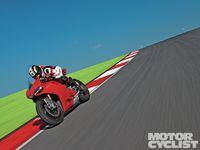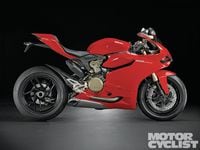By Aaron Frank | Photography by Ducati
[Moto bellissimo, no? An under-engine exhaust and side-mounted shock centralize mass, as do the stubby nose and tail that resemble a knife-edged 916.
Steel-trellis frames, “L-twin” engines, belt-driven cams, dry clutches… Certain features have been so core to Ducati superbikes for so long that it’s almost impossible to imagine them ever going away. Or so we thought, until Ducati’s groundbreaking 1199 Panigale was revealed. Described by company president Gabriele Del Torchio as “the most ambitious project in Ducati’s history,” this all-new superbike breaks free from 40 years of tradition and establishes a new paradigm of innovation and un- compromising design.
We've already covered the radical Superquadro engine in detail (Up To Speed, December 2011). Claimed to deliver 195 bhp and 98 lb.-ft. of torque, this super-compact engine is the most powerful production V-twin ever made. It should be more reliable, too, with roller chains and gears replacing toothed cambelts and the signature dry clutch jettisoned for a more durable wet unit. Now the complete bike has been revealed at the annual Milan Show—where it was voted "Most Beautiful Bike"—and we see the chassis and electronics are just as revolutionary.
Like Ducati's MotoGP racer, the Panigale has no frame per se. The die-cast aluminum subframe and steering head/airbox bolt directly to the cylinder heads, and the swingarm pivots in the rear of the crankcase. This arrangement is more compact and 11 lbs. lighter than a steel trellis. The engine is still a 90-degree V-twin, but it's rotated rearward 6 degrees and moved 32mm closer to the front wheel, increasing forward weight bias from 50 to 52 percent.
[With 195 bhp and a dry weight of just 362 lbs., the super-compact 1199 Panigale is said to have the highest power-to-weight ratio of any production motorcycle.
The Panigale breaks more new ground on the electronics front. The S-model features an Öhlins fork and shock equipped with Ducati Electronic Suspension (DES) that automatically adjusts compression and rebound damping according to three preset ride modes: Wet, Sport or Race. These modes also alter power delivery, traction-control settings, engine-braking management and, for the first time on a Ducati superbike, race-grade Brembo ABS. Traction-control and suspension-damping settings can also be adjusted independently, and the ABS can be switched off. A trick TFT instrument panel automatically reconfigures the information presented depending on which mode is selected.
The base 1199 Panigale will sell for $17,995. The DES-equipped S-version will go for $22,995, plus another $1000 for optional ABS. Desirable, innovative new models like the Diavel and Multistrada 1200 helped Ducati sell more than 42,000 motorcycles in 2011—its best year ever. The Panigale looks ready to continue that trend.












/cloudfront-us-east-1.images.arcpublishing.com/octane/S35YGSEMEZB4BLTDJTSZPF4GLA.jpg)
/cloudfront-us-east-1.images.arcpublishing.com/octane/5UOT6HPX2JFMRJAX6EH45AR4MQ.jpg)
/cloudfront-us-east-1.images.arcpublishing.com/octane/OKWOJWAKP5EP3OACCRRWPCIX2Q.jpg)
/cloudfront-us-east-1.images.arcpublishing.com/octane/2WF3SCE3NFBQXLDNJM7KMXA45E.jpg)
/cloudfront-us-east-1.images.arcpublishing.com/octane/G4MG6OUCJNBSHIS2MVVOTPX65E.jpg)
/cloudfront-us-east-1.images.arcpublishing.com/octane/IIGGWFOTOJGB7DB6DGBXCCMTDY.jpg)
/cloudfront-us-east-1.images.arcpublishing.com/octane/QSTCM6AVEZA5JJBUXNIQ3DSOF4.jpg)
/cloudfront-us-east-1.images.arcpublishing.com/octane/U4I7G625B5DMLF2DVIJDFZVV6M.jpg)
/cloudfront-us-east-1.images.arcpublishing.com/octane/B6XD6LS6IVCQPIU6HXDJSM3FHY.jpg)
/cloudfront-us-east-1.images.arcpublishing.com/octane/ICL63FEDDRDTTMINYICCEYGMDA.jpg)
/cloudfront-us-east-1.images.arcpublishing.com/octane/FCGZHQXRBZFLBAPC5SDIQLVF4I.jpg)
/cloudfront-us-east-1.images.arcpublishing.com/octane/WNOB6LDOIFFHJKPSVIWDYUGOPM.jpg)

/cloudfront-us-east-1.images.arcpublishing.com/octane/X33NU3E525ECRHXLNUJN2FTRKI.jpg)
/cloudfront-us-east-1.images.arcpublishing.com/octane/6KKT5NNL2JAVBOXMZYS5ZO76YA.jpg)
/cloudfront-us-east-1.images.arcpublishing.com/octane/J5RKG5O455GMPGQRF2OG6LRT7A.jpg)
/cloudfront-us-east-1.images.arcpublishing.com/octane/GX2CIZKQVRH2TATDM26KFG2DAE.jpg)
/cloudfront-us-east-1.images.arcpublishing.com/octane/ZWIDYSAKQZHD5BHREMQILXJCGM.jpg)
/cloudfront-us-east-1.images.arcpublishing.com/octane/CYUHJZCTSJCH3MRAQEIKXK7SCQ.jpg)
/cloudfront-us-east-1.images.arcpublishing.com/octane/LKOFINY56FCXJCANJ5M7ZDQUBY.jpg)
/cloudfront-us-east-1.images.arcpublishing.com/octane/4NBPDACMWJH63JQYJVK3QRBDZI.jpg)
/cloudfront-us-east-1.images.arcpublishing.com/octane/KKHQHRR3FJGX7H2IPU6RALMWG4.jpg)

/cloudfront-us-east-1.images.arcpublishing.com/octane/5IOFS5JAE5FOXMNA23ZRAVVYUU.jpg)